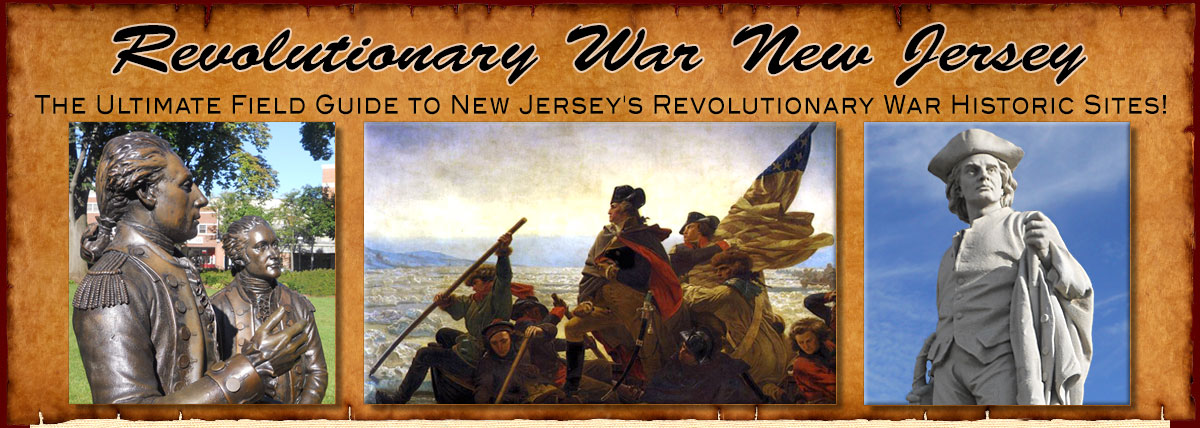

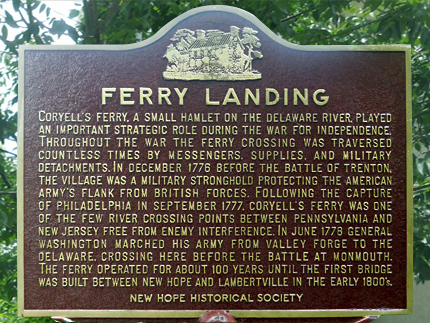
Ferry Landing sign - on the Pennsylvania side of the Delaware River.
In New Hope's Ferry Landing Park.
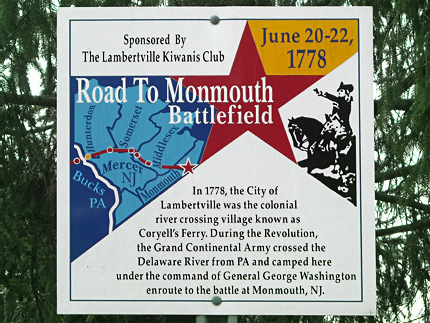
One of Several Road to Monmouth Battlefield signs,
In the Bridge St. / Union St area., by the Delaware River in Lambertville.
Coryell's Ferry Marker
On the Pennsylvania side of the Delaware River in New Hope
Map / Directions to the Coryell's Ferry Marker
Map / Directions to all Lambertville Revolutionary War Sites
Road to Monmouth Battlefield Markers
Several signs near Bridge St. and Union St., by the Delaware River
Map / Directions to Road to Monmouth Battlefield Markers
Map / Directions to all Lambertville Revolutionary War Sites
During the 1700's, a ferry named Coryell's Ferry operated on the Delaware River between what are now Lambertville, NJ, and New Hope, PA. At that time, both places were also called Coryell's Ferry, after the ferry. The ferry was an important crossing during the Revolutionary War. [1]
Coryell's Ferry's most notable role in the Revolutionary War occurred in June 1778, when the Continental (American) Army crossed here prior to the Battle of Monmouth. The events which set that crossing in motion began the previous autumn.
The British army occupied Philadelphia from September 26, 1777 until June 18, 1778. Philadelphia had been serving as the American capital, and the British occupation forced Congress to move to York, Pennsylvania, which had a demoralizing effect on the Americans.
During that same winter of 1777, General George Washington and his Continental (American) army were camped about twenty miles away from Philadelphia in Valley Forge, Pennsylvania. Valley Forge provided a good strategic location for the army's winter quarters: It was close enough to keep an eye on the British troops in Philadelphia but in a strong defensive position should the British decide to attack.
In early June 1778, the British forces in Philadelphia decided to abandon Philadelphia and march towards New York City, the main British stronghold in America. British forces under General Henry Clinton began their trip on June 18, 1777, when they crossed over the Delaware River at Coopers Ferry into New Jersey. From there, they began a march northeast across New Jersey. [2]
During this time, General Washington and his Continental Army were also on the move. After hearing of the British evacuation of Philadelphia, Washington made the decision to leave Valley Forge. On June 20, they arrived at the Pennsylvania side of Coryell's Ferry. The following day, General Washington crossed over into the New Jersey side (what is now Lambertville), and made his headquarters at the Holcombe house (see next entry below). On the 22nd, the main body of the troops also crossed over into New Jersey. Early the next morning, the army then began their march in pursuit of the British troops. [3] On June 28, they would encounter the British forces at Monmouth Courthouse and fight the Battle of Monmouth, the longest continuous battle of the war.
Other historical sites associated with the Continental Army's route to the Battle of Monmouth can be found in Mount Airy, Hopewell Borough, Cranbury. and Englishtown.

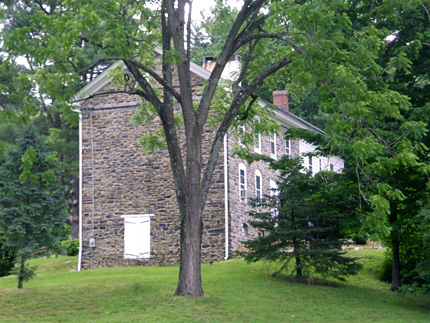
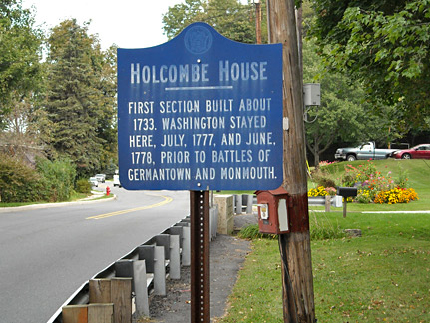
Holcombe House
260 North Main St.(Rte. 29)
Map / Directions to the Holcombe House
Map / Directions to all Lambertville Revolutionary War Sites
This house is a private residence.
Please respect the privacy and property of the owners.
General George Washington stayed at the Holcombe House twice during the Revolutionary War. This house was built by John Holcombe, an early settler of this area. At the time of the Revolutionary War, John's son Richard lived here with his wife Ann and their children. [4]
July 29-31, 1777
On July 29-31, 1777 Washington first used this house as his headquarters, while awaiting word as to the movements of the British fleet. A portion of his army was encamped with him in this area, while other parts of the army were farther south along the Delaware River. On July 30, he wrote to Major-General Horatio Gates in Philadelphia, "As we are yet uncertain as to the real destination of the Enemy, tho’ Delaware seems most probable, I have thought it prudent to halt the Army at this place, Howells Ferry and Trenton, at least, till the Fleet actually enter the Bay and put the matter beyond a doubt.." [5] (The bay Washington is referring to is the Delaware Bay, the entranceway to the Delaware River from the Atlantic Ocean, which passes between Cape May, NJ and Cape Henlopen, PA.)
The following day, Washington received word that the British fleet had landed at the Delaware Bay, and were likely planning to sail up the Delaware River and invade Philadelphia. Washington and his troops then left Coryell's Ferry, crossing over the Delaware River into Pennsylvania. [6] Over the next weeks, efforts were made to prevent the British fleet from moving up the Delaware River to Philadelphia. (See the Fort Billingsport and Fort Mercer entries on this website for more about this.) The British were prevented from reaching Philadelphia by the Delaware River. However, they were able to successfully invade Philadelphia by a different route; they sailed up the Chesapeake to a point where they could disembark and then march fifty miles to Philadelphia. The British took control of Philadelphia on September 26, 1777 and would remain there until June 18, 1778. During that time the Battle of Germantown, which is mentioned on the historic sign at the Holcombe house, was fought on October 4.
June 21-22, 1778
When British troops abandoned Philadelphia on June 18, 1778, it brought about the chain of events that would bring General Washington back to the Holcombe house. At the time of the Continental Army's crossing described in the Coryell's Ferry entry above, General Washington made his headquarters at this house on June 21-22, 1778. [7] Early on the morning of the 23rd, he and his army marched to Hopewell, where Washington dined at the house of Declaration of Independence signer John Hart. The army then continued its march across New Jersey, and on June 28 fight the Battle of Monmouth.

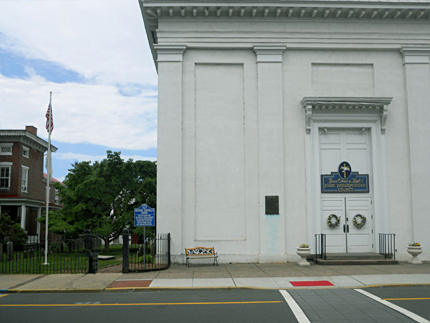
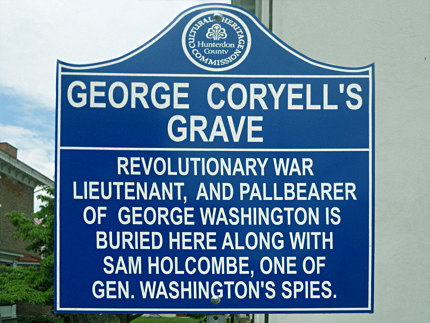
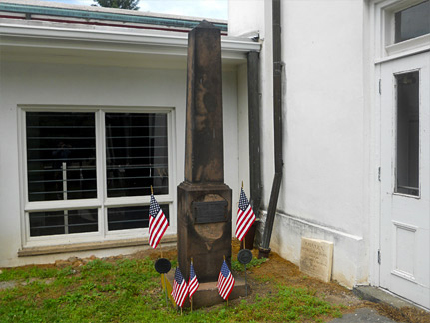
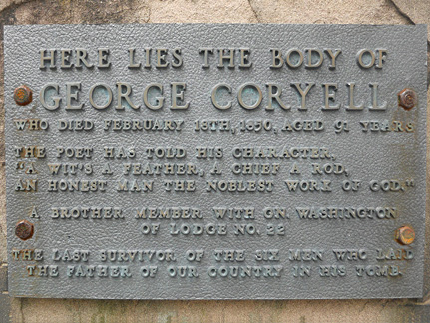
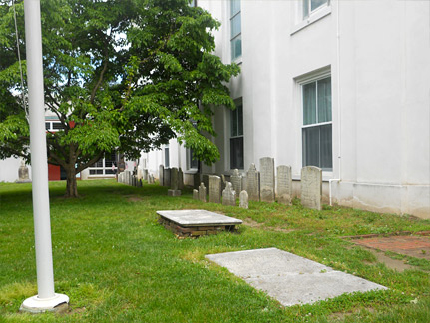
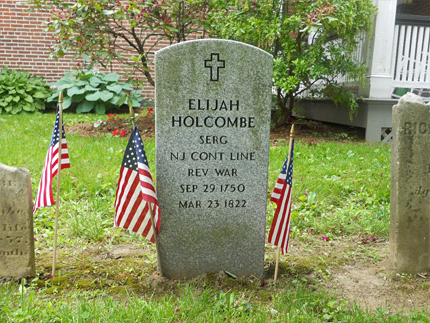
First Presbyterian Church Cemetery
31 North Union St.
Map / Directions to the First Presbyterian Church Cemetery
Map / Directions to all Lambertville Revolutionary War Sites
In the small cemetery alongside the First Presbyterian Church, there is an obelisk monument to mark the grave of George Coryell (shown above left). George Coryell was born in this area and later moved to Alexandria, Virginia, where he was a fellow member along with George Washington at Masonic Lodge No. 22.
Coryell attended Washington's December 18, 1799 funeral. Although he is sometimes described as a pallbearer at the funeral, his role was likely that of bier carrier. The distinction is that bier carriers carried the bier (a table-like structure which held the coffin on top) to the door of the tomb. The pallbearers then carried the coffin into the tomb.
Four men were designated bier carriers, and six men as pallbearers. George Coryell was not originally intended to be one of them. Coryell likely took the place of one of the bier carriers, William Moss, when Moss stumbled or fell ill while carrying the bier. [8]
George returned to Lambertville late in his life. He died on February 18, 1850, at the age of 91. George's family connections are worth noting. He was the grandson of Emanuel Coryell, the man for whom Coryell's Ferry was named. George's father Cornelius and uncle Abraham are buried near him in the cemetery; both served in the Revolutionary War. [9]
Also buried in this cemetery are Elijah Holcombe (September 29, 1750 - March 23, 1822), a sergeant in the New Jersey Continental Line; and Sam Holcombe, described as "one of Gen. Washington's spies." [10]

1. ^ This entry focuses on the role of Coryell's Ferry in June 1778, prior to the Battle of Monmouth. However, there was Revolutionary War activity in the area at other times throughout the war.
Notably, there was military activity at and around Coryell's Ferry in December 1776, around the time of the historic Crossing of the Delaware.
Coryell's Ferry is mentioned in three of George Washington's papers from December 1776 listed below.
Note that spelling tended to be inconsistent in 1700's America, and the name of the ferry is spelled differently in each document. ("Corells", "Corriels", and "Coryells". None of the three spellings includes the apostrophe.)“General Orders, 12 December 1776,” Founders Online, National Archives (http://founders.archives.gov/documents/Washington/03-07-02-0239 [last update: 2015-06-29]). Source: The Papers of George Washington, Revolutionary War Series, vol. 7, 21 October 1776–5 January 1777, ed. Philander D. Chase. Charlottesville: University Press of Virginia, 1997, pp. 303–304.
“From George Washington to John Hancock, 12 December 1776,” Founders Online, National Archives (http://founders.archives.gov/documents/Washington/03-07-02-0245 [last update: 2015-06-29]). Source: The Papers of George Washington, Revolutionary War Series, vol. 7, 21 October 1776–5 January 1777, ed. Philander D. Chase. Charlottesville: University Press of Virginia, 1997, pp. 309–312.
“General Orders, 29 December 1776,” Founders Online, National Archives (http://founders.archives.gov/documents/Washington/03-07-02-0370 [last update: 2015-06-29]). Source: The Papers of George Washington, Revolutionary War Series, vol. 7, 21 October 1776–5 January 1777, ed. Philander D. Chase. Charlottesville: University Press of Virginia, 1997, p. 476.
2. ^ For more information and accompanying source notes about the British crossing at Cooper's Ferry, and their subsequent march across New Jersey prior to the Battle of Monmouth, see the Camden, Haddonfield, Cherry Hill, Mount Laurel, Moorestown, Mount Holly, Crosswicks, and Upper Freehold pages of this website.
3. ^ Regarding the dating of events and troop locations for June 20 - 22, 1778, see the following papers of George Washington.
As with the papers noted in Source Note 1, the spelling of Coryell's Ferry varies from document to document.DATED JUNE 20, 1778:
“From George Washington to Major General Philemon Dickinson, 20 June 1778,” Founders Online, National Archives (http://founders.archives.gov/documents/Washington/03-15-02-0496 [last update: 2015-06-29]). Source: The Papers of George Washington, Revolutionary War Series, vol. 15, May–June 1778, ed. Edward G. Lengel. Charlottesville: University of Virginia Press, 2006, pp. 478–479.“From George Washington to Major General Philemon Dickinson, 20 June 1778,” Founders Online, National Archives (http://founders.archives.gov/documents/Washington/03-15-02-0497 [last update: 2015-06-29]). Source: The Papers of George Washington, Revolutionary War Series, vol. 15, May–June 1778, ed. Edward G. Lengel. Charlottesville: University of Virginia Press, 2006, p. 479.
“From George Washington to Major General Horatio Gates, 20 June 1778,” Founders Online, National Archives (http://founders.archives.gov/documents/Washington/03-15-02-0500 [last update: 2015-06-29]). Source: The Papers of George Washington, Revolutionary War Series, vol. 15, May–June 1778, ed. Edward G. Lengel. Charlottesville: University of Virginia Press, 2006, p. 481.
“From George Washington to Henry Laurens, 20 June 1778,” Founders Online, National Archives (http://founders.archives.gov/documents/Washington/03-15-02-0501 [last update: 2015-06-29]). Source: The Papers of George Washington, Revolutionary War Series, vol. 15, May–June 1778, ed. Edward G. Lengel. Charlottesville: University of Virginia Press, 2006, pp. 481–482.
DATED JUNE 21, 1778:
“General Orders, 21 June 1778,” Founders Online, National Archives (http://founders.archives.gov/documents/Washington/03-15-02-0504 [last update: 2015-06-29]). Source: The Papers of George Washington, Revolutionary War Series, vol. 15, May–June 1778, ed. Edward G. Lengel. Charlottesville: University of Virginia Press, 2006, p. 483.
▸ Also note the James McHenry diary entry shown in the source notes, which specifically mentions "Head Quarters at one Holcombs in the Jersey."“From George Washington to Major General Benedict Arnold, 21 June 1778,” Founders Online, National Archives (http://founders.archives.gov/documents/Washington/03-15-02-0507 [last update: 2015-06-29]). Source: The Papers of George Washington, Revolutionary War Series, vol. 15, May–June 1778, ed. Edward G. Lengel. Charlottesville: University of Virginia Press, 2006, p. 487.
DATED JUNE 22, 1778:
“General Orders, 22 June 1778,” Founders Online, National Archives (http://founders.archives.gov/documents/Washington/03-15-02-0515 [last update: 2015-06-29]). Source: The Papers of George Washington, Revolutionary War Series, vol. 15, May–June 1778, ed. Edward G. Lengel. Charlottesville: University of Virginia Press, 2006, pp. 492–495.
“From George Washington to Major General Philemon Dickinson, 22 June 1778,” Founders Online, National Archives (http://founders.archives.gov/documents/Washington/03-15-02-0519 [last update: 2015-06-29]). Source: The Papers of George Washington, Revolutionary War Series, vol. 15, May–June 1778, ed. Edward G. Lengel. Charlottesville: University of Virginia Press, 2006, p. 497.
“From George Washington to Henry Laurens, 22 June 1778,” Founders Online, National Archives (http://founders.archives.gov/documents/Washington/03-15-02-0523 [last update: 2015-06-29]). Source: The Papers of George Washington, Revolutionary War Series, vol. 15, May–June 1778, ed. Edward G. Lengel. Charlottesville: University of Virginia Press, 2006, pp. 505–506.
4. ^ For more information about the house and the Holcombe family, see:
• Mabel Lorenz Ives, Washington's Headquarters, (Upper Montclair: Lucy Fortune, 1932) pages 133-130
• Sarah A. Gallagher, 1703-1903. Early History of Lambertville, N.J (Trenton: MacCrellish & Quigley, 1903) pages 5-7
Available to be read at the Internet Archive here5. ^ Washington's papers from July 29 - 31, 1777 are marked as being at Coryell's Ferry, or some variation (such as: Headquarters at Coryell's Ferry, Camp at Coryell's Ferry, Quarters at Coryell's Ferry)
• The quoted text is from:
“From George Washington to Major General Horatio Gates, 30 July 1777,” Founders Online, National Archives (http://founders.archives.gov/documents/Washington/03-10-02-0457 [last update: 2015-06-29]). Source: The Papers of George Washington, Revolutionary War Series, vol. 10, 11 June 1777 – 18 August 1777, ed. Frank E. Grizzard, Jr. Charlottesville: University Press of Virginia, 2000, p. 459.6. ^ For George Washington's mention of receiving information that the British fleet had arrived at Delaware Bay, and his orders to move the army across the Delaware into Pennsylvania, see the following two documents from July 31, 1777:
“From George Washington to Major General Israel Putnam, 31 July 1777,” Founders Online, National Archives (http://founders.archives.gov/documents/Washington/03-10-02-0471 [last update: 2015-06-29]). Source: The Papers of George Washington, Revolutionary War Series, vol. 10, 11 June 1777 – 18 August 1777, ed. Frank E. Grizzard, Jr. Charlottesville: University Press of Virginia, 2000, pp. 468–469.
“General Orders, 31 July 1777,” Founders Online, National Archives (http://founders.archives.gov/documents/Washington/03-10-02-0465 [last update: 2015-06-29]). Source: The Papers of George Washington, Revolutionary War Series, vol. 10, 11 June 1777 – 18 August 1777, ed. Frank E. Grizzard, Jr. Charlottesville: University Press of Virginia, 2000, pp. 465–466.
7. ^ Regarding the dating of events and troop locations for June 20 - 22, 1778, see the documents listed in Source Note 2 above
• See also:
John C. Fitzpatrick, The Writings of George Washington from the Original Manuscript Sources 1745-1799 Volume 12 June 1, 1778-September 30, 1778 (Washington D.C.: United States Government Printing Office, 1934)
▸This work records the following receipt to Richard Holcombe for expenses during George Washington's June 1778 stay at the house:
"1778, June 23. To Cash paid Richard Holcombe as pt. bill £ 10: 17: 16.”—“Headquarters Account Book” in the Washington Papers. This bill is also in the Washington Papers and is receipted as paid June 22 “Near Coryells Ferry, 9 oClock evnig” and was for 38 dinners @ 3/9, “bread butter and other necessaries £ 1:17:6” and “To Trouble &c. made in the house £ 1:17:6."8. ^ Regarding the role of George Coryell at George Washington's funeral, and how he came to unexpectedly become one of the bier carriers, see the following:
• The Research & Collections section of the George Washington's Mount Vernon website
The Pallbearers page lists six men as having served as pallbearers, and does not include George Coryell.
The six men listed as pallbearers are: Colonel Charles Little, Colonel Charles Simms, Colonel William Payne, Colonel George Gilpin, Colonel Dennis Ramsay, Colonel Philip Marsteller.
The Bier Carriers page lists five men as bier carriers:
Lawrence Hooff, Jr., James Turner, George Wise, William Moss and George Coryell
▸The notes for William Moss contain a quote that he "broke down under the weight of the casket in removing the bier from the mansion to the tomb."
• Charles Hilliard Callahan, Washington: The Man and the Mason (Washington, D.C. Press of Gibson Bros., 1915 "Published under the auspices of the Memorial Temple Committee of the George Washington Masonic National Memorial Association") page 297 - 302
Available to be read at Google Books hereThis work contains a description of the funeral which includes a list of six pallbearers, which agrees with the list on the Mount Vernon website.
It names four of the five men as bier carriers who are named on the Mount Vernon website, but does not list Coryell among them.
George Coryell is listed as one of the members of Masonic Lodge No. 22 in attendance, but his specific role is not mentioned.
Callahan describes the carrying of the bier as a task separate from the pallbearers:
"Passing between the divided columns, the bier, bearing the encoffined Washington, was placed at the door of the sepulchre."
And then later:
"The pall-bearers placed their precious burden in the tomb's cold embrace, earth was cast on the threshold, and the words were spoken: 'Earth to earth — ashes to ashes — dust to dust!' and the entombment of Washington was finished."
• Hillel Kuttler, "Remembering the passing of a president Re-enactment: Mount Vernon Officials Hope the Anniversary of George Washington's Death will spur Visitors to Celebrate his Life,"The Baltimore Sun, December 17, 1999
Kuttler's article is about the 200th Anniversary re-enactment of Washington's funeral at Mount Vernon. It is based in part on statements by Dennis Pogue, who was then Mount Vernon's Associate Director for Preservation. The article states:
"Coryell was standing nearby when the procession turned from the mansion onto the estate's South Lane. Just then, one of the bier carriers, Lt. William Moss, stumbled. Coryell jumped in to prevent the bier sliding off the man's shoulder.
"To provide the most authentic experience, said Pogue, the four contemporary bier carriers are practicing the near-fall, which they hope to perfect in a dress rehearsal this afternoon."
It appears that the re-enactors were not able to perfect the near-fall and did not perform it during the reenactment.
The re-enactment of Washington's Funeral was filmed by C-Span. The section of the video which shows the bier carriers can be seen here.
The stumble moment is not visible. However, there is a short time where the view is obscured by shrubbery, so it may have occurred then.To add further confusion to this already complicated topic, the re-enactment depicted the same men acting as the pallbearers and the bier carriers.
However, viewing the video does make it clear the distinction of carrying the bier to the entrance of the tomb, as opposed to carrying the casket inside the tomb.
Note: for those who would like to watch the entire three hour and twenty-two minute video of the re-enactment, the full video can be seen on the C-Span website here.
• Sarah A. Gallagher, 1703-1903. Early History of Lambertville, N.J (Trenton: MacCrellish & Quigley, 1903) pages 13-14
Available to be read at the Internet Archive hereThe writer of this book, Sarah A. Gallagher, states that she had known George Coryell. She was born in 1821, and so would have been twenty-nine when George Coryell died. She writes on page 14, "The writer was well acquainted with Mr. Coryell, and talked with him about George Washington's funeral, knowing that he had been one of the bearers on that occasion."
Regarding the role George Coryell played in George Washington's funeral, she writes:
"He was a fellow-Mason with George Washington in the Masonic Lodge at Alexandria, Va., and, as is stated on the monument, the last survivor of the six men who laid the 'Father of his Country' in his tomb. Lest some one question the historic accuracy of this statement, it should be mentioned that, as a member of the lodge, next in degree, Mr. Coryell was called on to take the place of one of the six pall-bearers selected — (Lieutenant) Moss, who was taken ill."
It would appear that this description generally fits with the other accounts, except that it mistakenly identifies Moss as a pallbearer rather than a bier carrier, and therefore mistakes Coryell's role when he took Moss's place.
It should be remembered that Sarah A. Gallagher would have spoken to George Coryell decades after Washington's funeral, and then wrote her book a half century after that. Therefore, it is very plausible that there was a simple mistake or miscommunication regarding the role Coryell played.
One final note regarding the bier used at Washington's funeral:
A footnote in the above-mentioned Charles Hilliard Callahan book Washington: The Man and the Mason states "The bier on which the body was borne to the tomb became the property of Alexandria Lodge No 2 and was destroyed at the burning of the Temple in 1871."A description and drawing of the bier appears in:
Benson John Lossing, The Home of Washington and Its Associations, Historical, Biographical, and Pictorial (New York: W. A. Townsend, 1866) page 329
Available to be read at Google Books here
▸ This book was published six years before the bier was destroyed in the 1871 fire, and so the bier was available for the author to see it in Alexandria.9. ^ Coryell family information was drawn from:
Sarah A. Gallagher, 1703-1903. Early History of Lambertville, N.J (Trenton: MacCrellish & Quigley, 1903) pages, 8 and 12-13
Available to be read at the Internet Archive here• Cornelius and Abraham Coryell are both listed in the Daughters of the American Revolution Genealogical Research System, where they are Ancestors # A026293 and A026292
10. ^ Information drawn from Elijah Holcombe's gravestones and the Hunterdon County Cultural & Heritage Commission sign in front of the church